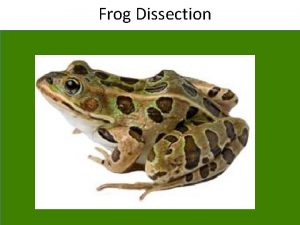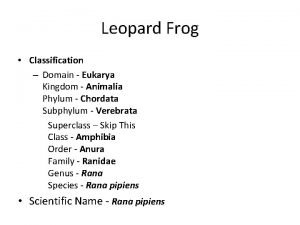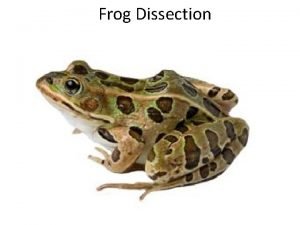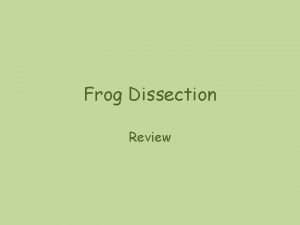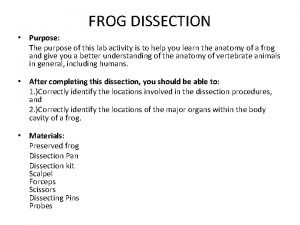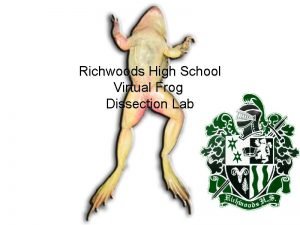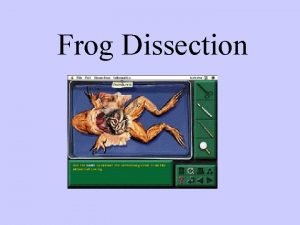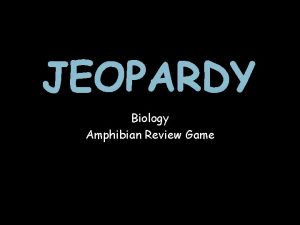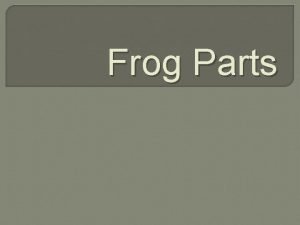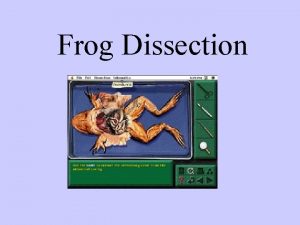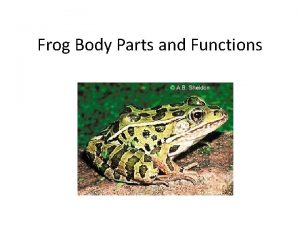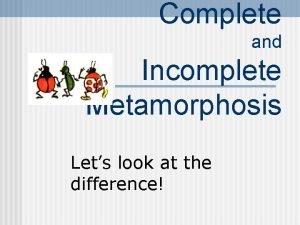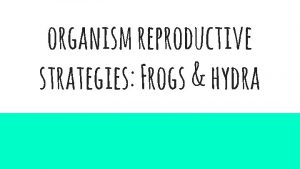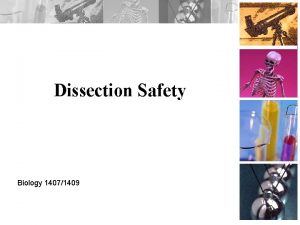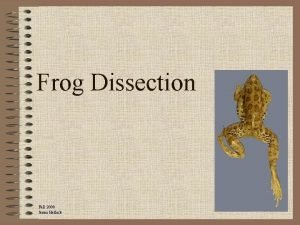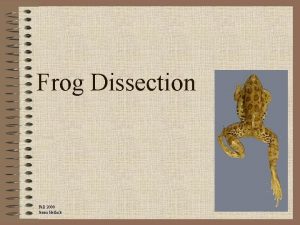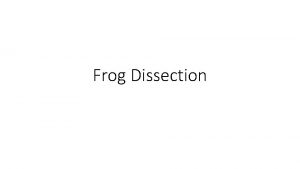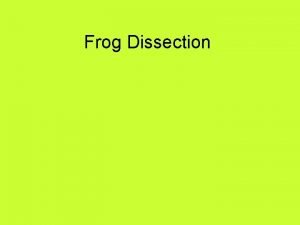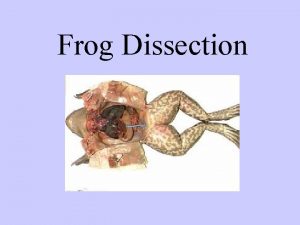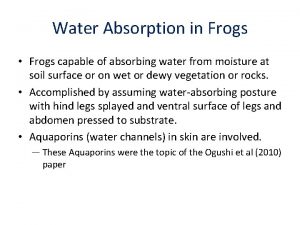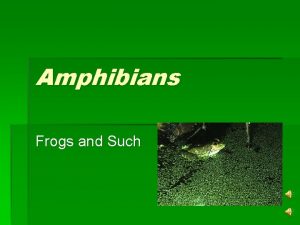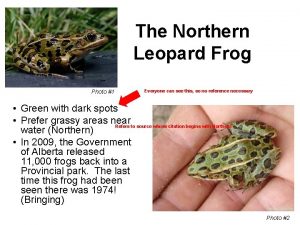Frog Dissection Leopard Grass Frog Frogs are said































- Slides: 31

Frog Dissection

Leopard Grass Frog • Frogs are said to have two lives. – Why? • Because the live in water the first part of their lives and land for the rest of their lives

Tools • • A dissecting tray A frog Forceps Scissors Pins Probe Goggles Gloves

Terminology • Dorsal-on or relating to the upper side or back of an animal • Ventral-on or relating to the underside of an animal (opposite of dorsal) • Posterior-on or near the behind or back • Anterior-near the front or the head Anterior Dorsal Posterior Ventral

External Anatomy of the Frog

External Anatomy of the Frog

Determine if your frog is a Male or Female The sex of a frog may be determined externally by examining the thumb pads on the front feet. The thumb pads of males are enlarged at the base as in the drawing on the right.

External Anatomy of the Frog’s Head Nictating Membrane Frontal Membrane Tympanic Membrane External Nares

Internal Anatomy of the Frog’s Head Maxillary Teeth Vomerine. Teeth Internal Nares Esophagus Glottis Eustachian tube opening Tongue

Functions of the body parts that make up the frog’s head • External nares or nostrils - Anterior openings for the entry or exit of air. • Esophagus - Tube that connects the mouth and the stomach in a frog. • Tympanic Membrane - The eardrum - receives sound waves • Glottis - The opening from the mouth into the respiratory system

Functions of the body parts that make up the frog’s head • Tongue - Muscular structure attached to the front of the mouth which is extended to catch insects (its food). • Maxillary Teeth - Sharp teeth in the maxilla of a frogs mouth that function in holding captured prey. • Vomerine Teeth - Small projections in the top of a frog’s mouth that function in holding and captured prey. • Eustachian tube openings - Openings in the mouth that lead to tubes that connect to the middle ear to equalize air pressure

Nictating Membrane

Functions of the External Anatomy of the Frog • Nictitating Membrane - A transparent part of a frog’s lower eyelid that moves over the eye to clean it and protect it. • Cloacal Opening - Opening of cloaca through which undigested food, urine, eggs, and sperm are passed.

Internal Anatomy

Functions of the Internal Anatomy of a Frog: • Stomach - Stores food and mixes it with enzymes to begin digestion. • Small Intestine - The principal organ of digestion and absorption of digested food. • Duodenum - The anterior (front) part of the small intestine into which food passes from the stomach • Pancreas - Gland which secretes digestive enzymes into the duodenum. • Gall Bladder - Sac which stores bile.

Functions of the Internal Anatomy of a Frog: • Large Intestine - Posterior organ of the digestive system which stores undigested food. • Liver - Secretes bile and processes digested food molecules • Urinary Bladder - The organ that collects and stores urine until released. • Fat Bodies - Masses of fat in the body cavities of frogs. Needed for hibernating and mating • Spleen - Organ in the frog’s circulatory system that makes, stores, and destroys blood cells. • Cloaca - Organ through which the products of the frogs digestive and urogenital system pass when discharged from the body.

Digestive System


Small Intestines Liver

Respiratory System

Circulatory System

Anatomy of a Frog Heart

Functions of the Frog Heart • Heart - Pumping organ of the circulatory system (has 3 chambers). • Anterior Vena Cava - Large vein that carries blood from the anterior part of the body toward the heart. • Posterior Vena Cava - Large vein that carries blood from the posterior part of the body towards the heart. • Sinus Venosus - Sac that receives blood from the vena cava

Functions of the Frog Heart • Right Atrium - Chamber of the frogs heart which receives blood from the sinus venosus. • Left Atrium - The chamber of the heart that receives blood from the lungs. • Pulmonary Veins - The blood vessels that carry blood form the lungs to the left atrium. • Ventricle - Chamber of a frog’s heart that pumps blood out of the heart to the lungs and other parts of the body. • Truncus Arteriosis - Large artery in a frog that carries blood away from the ventricle into branches that lead to all parts of the body.

Urinary System

Frog Brain

Functions of the Frog Brain • Spinal Cord - Main pathway to and from the brain • Spinal Nerves - Nerves that lead to and from the spinal cord • Olfactory Lobe - Part of the frog’s brain associated with the sense of smell • Cerebrum - Part of the brain that is associated with memory, pain, and voluntary muscle control. • Optic Lobes - Part of the brain associated with vision.

Functions of the Frog Brain • Cerebellum - Part of a brain that influences balance and equilibrium. • Medulla Oblongata - Part of a brain that is the center for some involuntary functions. • Cranial Nerves - Nerves that lead to and from the brain.

Frog Reproductive System

Frog Reproductive System Functions • Urinary Ducts - Tubes in a frog that carry urine from the kidneys to the cloaca • Urinary Bladder - The organ that collects and stores urine until released. • Adrenal Glands - Organs located near the kidneys which secrete hormones. • Ova or Eggs - Female sex cell or gametes

Frog Reproductive System Functions • Ovaries - Organs of the female reproductive system that produce the eggs. • Oviducts - Tubes of a female frog’s reproductive system that carry eggs from the ovaries to the cloaca. • Testes - Male sex organs that produce sex cells (sperm). • Sperm - Male sex cell or gametes. • Seminal Vesicles - Enlarged distal sections of the male frog’s urinary ducts that collect sperm prior to entry into the cloaca.
 Frog
Frog Antigentest åre
Antigentest åre Frog dissection frog scienstructable template
Frog dissection frog scienstructable template Lifespan of snow leopard
Lifespan of snow leopard Getting nerdy science answer key
Getting nerdy science answer key Long wavy grass bear hunt
Long wavy grass bear hunt Classification of leopard frog from kingdom to species
Classification of leopard frog from kingdom to species Frog dissecting tray
Frog dissecting tray Dissection 101 frog powerpoint quiz
Dissection 101 frog powerpoint quiz Frog mouth dissection
Frog mouth dissection Frog's body parts
Frog's body parts Frog dissection external anatomy
Frog dissection external anatomy Frog dissection prelab
Frog dissection prelab Frog
Frog Frog dissection labeled
Frog dissection labeled Virtual earthworm dissection lab
Virtual earthworm dissection lab Frog
Frog A little bird by aileen fisher
A little bird by aileen fisher Jeopardy what are frogs
Jeopardy what are frogs Vomerine teeth of frog
Vomerine teeth of frog What type of energy is a leaping frog
What type of energy is a leaping frog One more night with the frogs
One more night with the frogs Temperate forest frog
Temperate forest frog Frog brain
Frog brain Frog external body parts and functions
Frog external body parts and functions Cassandra make a venn diagram
Cassandra make a venn diagram Duodenum frog
Duodenum frog Do frogs have teeth
Do frogs have teeth Whats the difference between habitat and niche
Whats the difference between habitat and niche Frog anatomy functions
Frog anatomy functions Frog incomplete metamorphosis
Frog incomplete metamorphosis Silence of the frogs
Silence of the frogs
